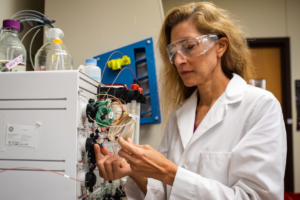We hear a lot of doom-and-gloom about the future.
The world will be too hot, too crowded. There will be too few resources and more competition for them.
We asked University of Texas at Austin researchers for the opposite — the ideas, technologies, policies or combinations that will make it possible for the world to be a better place in the future.
In this third installment of “The Big Question” series, Engineering Professor Kara Kockelman responds to the question “What in your field could make the world a better place?”
____________________________

With population and standards of living rising, associated transportation congestion, energy demands and environmental impacts are serious concerns. In terms of advances that will enhance our future, I am most excited about vehicle sharing, vehicle propulsion and vehicle safety technologies.
We can free up scarce space (and financial resources) by relying on shared vehicles only when needed (for example, a neighborhood block’s pickup truck for that once-a-year furniture haul), and turning to smaller, more efficient vehicles and alternative modes the rest of the time. Renting “the car next door” is made easy thanks to online market-makers like whipcar.com (now in London), with many owners’ vehicles paying for themselves. Car2Go, ZipCar and similar business models are helping many individuals live vehicle-free (including UT students, even while visiting other car-sharing cities). With high shares of urban land and over 15 percent of household budgets devoted to personal transport, change is needed.
Plug-in vehicles, like the Nissan Leaf and Chevrolet Volt, will help us electrify our miles, breaking the poisonous reliance our nation — and so many others — have on foreign oil markets. Advances in battery systems and hybrid-drive technologies can also wean us off unstable energy sources, enhancing international policymaking and securing our economic future. Of course, power generation is not costless or without environmental impacts. Advances in offshore wind-field use, solar-energy-harnessing films, algae-based fuels, carbon sequestration techniques and more affordable energy storage (to address power intermittency for meeting peak loads) are needed — and coming.
Traffic crashes cost the nation twice as much as roadway congestion each year. While fatal crashes seem like rare events, they are a top cause of death, including number one for those under age 35. Sweden and Norway now have “Vision Zero” plans, to bring the death toll (and serious injury by crash) down to nothing. U.S. crash rates are enjoying some noticeable reductions, thanks in part to the introduction of electronic stability control systems, required in all new light-duty vehicles in 2012 models and newer. Automated vehicle response to detected obstacles (including congestion up ahead), tire-pressure monitoring systems, and lane-departure warnings will also help. (Low-tech solutions like speed governors kicking in at 80 miles per hour would also be quite helpful, but those are not yet on the table for discussion.) Of course, adding Internet consoles to the fleet may further distract drivers, requiring that protections be built in. It will be interesting to see how such abuses are moderated via policy and technological adaptation (such as systems to block your teenage driver’s cell phone calls en route).
Other innovations in the world of transport include smart phones (providing real-time route guidance information to minimize delays), smart parking meters (whose rates vary with demand, and whose availability is communicated to drivers), and real-time bus location information (presented to potential riders). All offer meaningful benefits to the sea of travelers. Ultimately, however, the future depends on how quickly habit-biased humans adopt these and other opportunities.
Dr. Kara Kockelman is a professor in the Department of Civil, Architectural and Environmental Engineering in the Cockrell School of Engineering.



